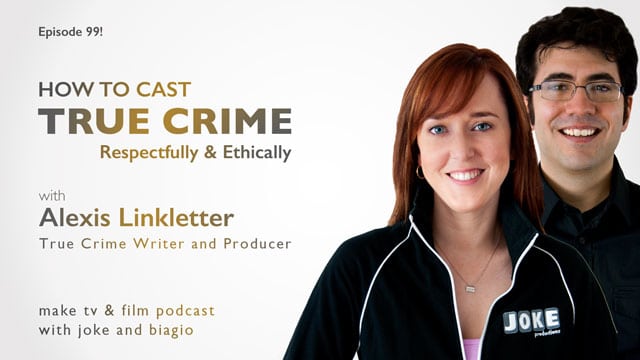Podcast: Play in new window | Download (Duration: 21:19 — 20.8MB)
Subscribe: RSS
Casting true crime projects takes special care. With networks hungry for true crime programming, the genre is currently exploding. But every true crime project has one essential element that can’t be forgotten. At its center is someone who went through a tragedy. It might be a survivor, or friends and family members of a victim. Many want to share their stories. Many don’t. So how do you reach out in the most courteous, professional manner? Here’s how to find and approach survivors and victim’s families respectfully. These tips work for any true crime project including documentaries and TV series. Plus, how to recognize which stories will translate to film or TV, and which should be told in another medium. Know these tips before you start casting true crime.

Casting True Crime – A Serious Responsibility
For all the reasons mentioned above, casting true crime docs or series is not something to be taken lightly.
Yet, we (and network execs we’ve spoken with) often receive show pitches or stories that feel “cold.” These pitches forget that, aside from a headline-grabbing crime, real people were hurt.
Further, many aspiring producers come up with flashy titles or wild story structures, forgetting to see if the project is castable.
You want to avoid these rookie mistakes. More importantly, you don’t want to add undue pain to people whose stories you hope to tell.
That’s why you need to start casting true crime projects as they’re conceived. You don’t want to create concepts that aren’t based on real cases. And you never want to pitch a specific crime story without first talking to those involved.
What You Need to Know About Casting True Crime
Today, we discuss a lot:
- How do you find families and stories that fit within parameters of a given format?
- How do you approach survivors and victim’s families respectfully and ethically?
- Why do people choose to open up and tell their stories?
- What is an adjudicated case and why is that important when casting true crime projects?
- Which story elements must you consider before casting true crime projects?
- Once you decide you’ve discovered a solid story, what’s your next step?
- A technique to help determine if a survivor or victim’s family member may be open to talking before you ever contact them.
- Preparing yourself for a variety of reactions when your reach out to victims.
- The process of reaching out to law enforcement and asking for their participation on your doc or series.
- What is a P.I.O. and why should you care?
- The ethical rule you should follow before moving forward with a true crime story.
- What is archival? What’s the importance of archival assets when casting true crime projects?
- How can police help you find the right archival?
- And…on a lighter note…what we WON’T be doing for our 100th episode of Producing Unscripted!
Press that giant PLAY button up top for professional tips, earned from years of experience, on how to go about ethically and respectfully casting true crime projects.
Helpful and Related Links
- Follow us on Twitter: @JokeAndBiagio – we’re around often and try to respond to most tweets.
- 5 Tips: Develop True Crime Deep Dives – Tips on developing series like The Jinx, Making a Murderer, and our own upcoming CNN/HLN series, Unmasking a Killer
- Cinematic Storytelling with Reenactments – The process that goes into creating a visual style for shows that use reenactments.
- How We Sold our New Show – Step by Step – The exact steps we went through to set up our very first true crime TV series, She Made Me Do It
- Alexis has a new website coming soon: http://alexislinkletter.com/
Let’s Make Some TV Together
Are you looking to make it in true crime, unscripted television, documentary series, or reality TV? Want to pitch to our company? Here’s what you should do next:
